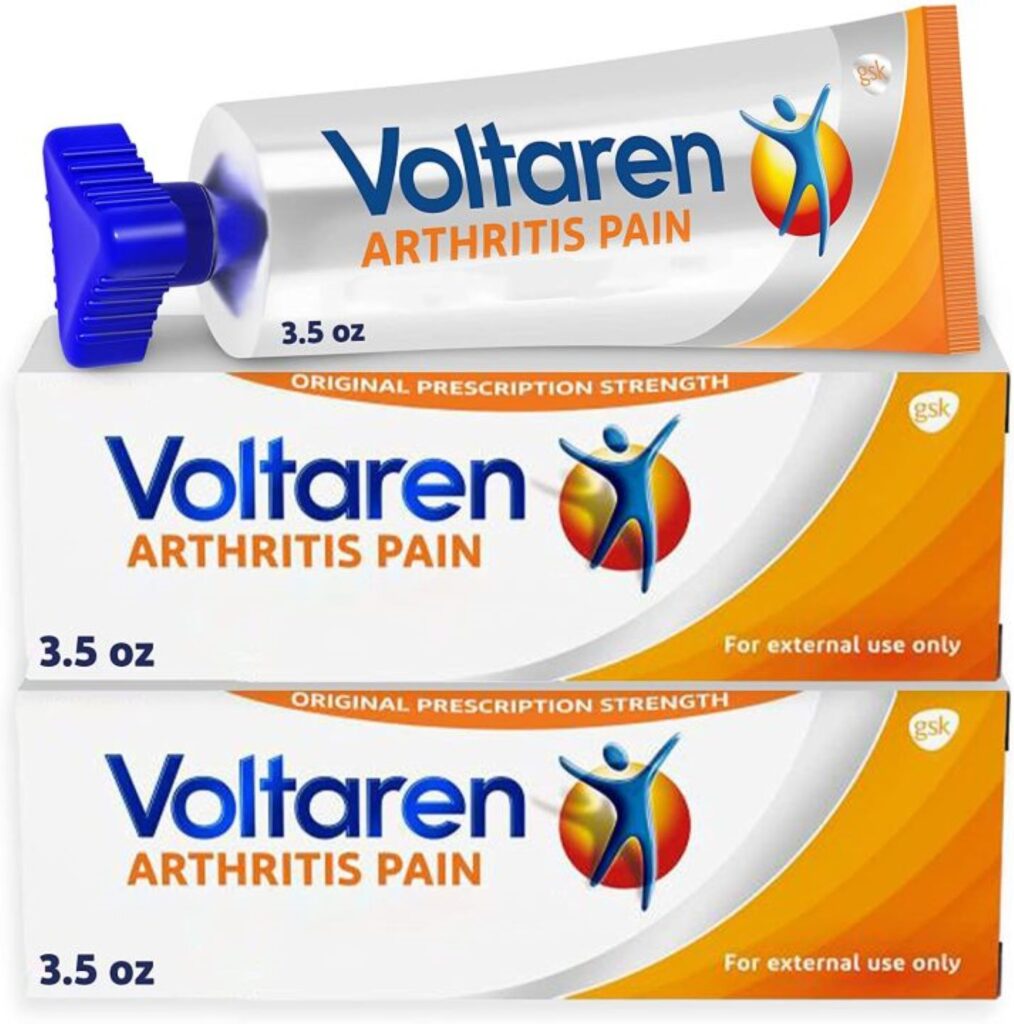Alternative Treatments, Joint Health
Voltaren Cream: A Topical Solution for Arthritis
Arthritis, a disorder marked by joint inflammation and stiffness, can have a substantial influence on daily life, complicating even routine tasks.
While there are several therapy alternatives available, Voltaren cream has become a popular choice for controlling arthritis symptoms.
Voltaren cream, a topical nonsteroidal anti-inflammatory medicine (NSAID), provides focused pain treatment by directly applying medication to the afflicted area, avoiding the systemic adverse effects of oral medications. In this article, we will look at the benefits, uses, and considerations of Voltaren cream as a topical arthritis treatment, giving readers useful insights on how to properly manage their joint pain.

Understanding Arthritis and Voltaren
What Is Arthritis?
Arthritis is a prevalent disease that affects millions of individuals globally. It is a condition that produces inflammation in one or more joints, resulting in discomfort and stiffness. There are about 100 different forms of arthritis, with osteoarthritis and rheumatoid arthritis being the most prevalent.
Rheumatoid arthritis is an autoimmune illness in which the immune system attacks the joints, whereas osteoarthritis is caused by joint wear and tear. Both types of arthritis can cause joint pain, swelling, and stiffness, making it difficult to perform regular activities.
How Voltaren Cream Works
Voltaren cream, a nonsteroidal anti-inflammatory medication (NSAID), contains diclofenac sodium. Diclofenac is a powerful anti-inflammatory medication that acts by inhibiting the formation of prostaglandins, which cause inflammation and discomfort.
When applied topically, Voltaren penetrates the skin and into the damaged joint, providing targeted relief from joint pain and inflammation. Voltaren, unlike oral NSAIDs, has a lower risk of gastrointestinal adverse effects because it is administered directly to the afflicted joint.
Overall, Voltaren cream is an effective treatment for arthritis pain. It delivers focused treatment for joint pain and inflammation while avoiding the gastrointestinal side effects associated with oral NSAIDs. If you are having joint pain or stiffness, consult with your doctor to see if Voltaren cream is correct for you.

Using Voltaren Cream Safely
Proper Application Techniques
When using Voltaren to treat arthritic pain, it is critical to use precise application procedures. The enclosed dosage card should be used to determine the appropriate dose, which should be applied inside the oblong region of the card up to the 2 or 4-gram line. Use 2 grams of cream per elbow, wrist, or hand, and 4 grams per knee, ankle, or foot.
Before applying Voltaren lotion, thoroughly clean your hands with soap and water. The afflicted region should be clean and dry. Apply the cream to the affected region and gently massage it in until absorbed. Do not use the cream on open wounds, cuts, or infected areas of the skin.
Potential Side Effects and Precautions
Voltaren cream, like any drug, can produce negative effects. Voltaren cream’s common side effects include skin irritation, redness, itching, and dryness. These side effects are typically minimal and resolve on their own within a few days.
However, if you notice any of the following significant adverse effects, stop taking Voltaren and get medical assistance right away:
- Allergic reaction (rash, hives, swelling in the cheeks, lips, tongue, or throat)
- Stomach discomfort, nausea, vomiting, or diarrhea.
- Chest pain, shortness of breath, or weakness on one side of your body
- Signs of a skin infection include swelling, warmth, redness, and leaking.
If you have a history of stomach ulcers, blood disorders, or heart illness, consult your doctor before taking Voltaren lotion.
Interactions with Other Medications
Voltaren cream can interact with other medications, such as blood thinners, aspirin, and nonsteroidal anti-inflammatory drugs (NSAIDs). Before using Voltaren cream, notify your doctor about all medications you are presently taking.
In addition, Voltaren cream should not be combined with other topical drugs because it may raise the risk of side effects. If you are using other topical drugs, see your doctor before using Voltaren.
Overall, Voltaren is a safe and efficient way to treat arthritic pain when taken as directed. By using suitable application techniques and taking the required precautions

Who Should Not Use Voltaren Cream
Voltaren cream is a topical nonsteroidal anti-inflammatory medication (NSAID) used to treat arthritis-related pain and inflammation. However, certain groups of people should avoid using Voltaren cream due to the risks and adverse effects linked with it.
Pre-Existing Health Conditions
Individuals with pre-existing health concerns such as heart disease, kidney illness, high blood pressure, or stomach bleeding should not take Voltaren lotion unless they visit their doctor first. This is because Voltaren cream can aggravate these illnesses and increase the likelihood of side effects.
Age and Voltaren Use
Voltaren cream should be used with caution by older persons and children. Voltaren cream’s adverse effects, including gastrointestinal bleeding and kidney issues, may be more prevalent in older persons. Children under the age of 18 should not use Voltaren cream unless advised to do so by a healthcare professional.
Pregnant women should avoid taking Voltaren cream, especially during the third trimester, because it can harm the unborn child. Breastfeeding mothers should see their doctor before using Voltaren cream, as it can transfer into breast milk and harm the nursing baby.
In conclusion, Voltaren cream is an effective drug for treating arthritic pain and inflammation, but it is not appropriate for everyone. Individuals with pre-existing health conditions, older adults, children, pregnant women, and breastfeeding women should take Voltaren cream with caution and consult their healthcare professional first.

Alternatives and Complementary Therapies
Other NSAIDs and Pain Relievers
While Voltaren cream is an excellent pain reliever for arthritis, other NSAIDs and pain medications can be used as a substitute. Over-the-counter pain relievers for arthritis include ibuprofen, aspirin, and naproxen. However, it is crucial to note that these medications might cause side effects such as stomach irritation and bleeding, so they should be used with caution.
Non-Medication Options
In addition to medicine, non-medication approaches can be utilized as supplementary therapy to relieve arthritis pain. Heat therapy, such as using a heating pad or having a warm bath, can help with stiffness and range of motion. Physical therapy can also assist improve joint function and relieving discomfort.
Topical lotions with salicylates, such as Aspercreme, can also provide short relief for mild to severe arthritic pain. However, it is crucial to remember that these creams should not be combined with other NSAIDs because they can raise the risk of negative effects.
Overall, it is critical to speak with a medical professional to establish the best course of action for arthritic pain. While Voltaren cream is a feasible option, other options and complementary therapies can be utilized in conjunction for the best pain relief.
Conclusion
Finally, Voltaren is an effective topical treatment for arthritis, providing focused relief from joint pain and inflammation. Its nonsteroidal anti-inflammatory qualities make it a viable alternative to oral drugs, giving localized relief without the risk of systemic adverse effects. Individuals who learn how to use Voltaren cream correctly and incorporate it into a comprehensive arthritis management plan might enjoy greater comfort and mobility in their daily lives.
However, before using Voltaren, contact with a healthcare practitioner, especially if you have an underlying medical condition or are using other medications. Voltaren can be a useful tool in the holistic approach to arthritis therapy when used properly and according to the suggested dosage.
Trusted Health, Wellness, and Medical advice for your well-being



